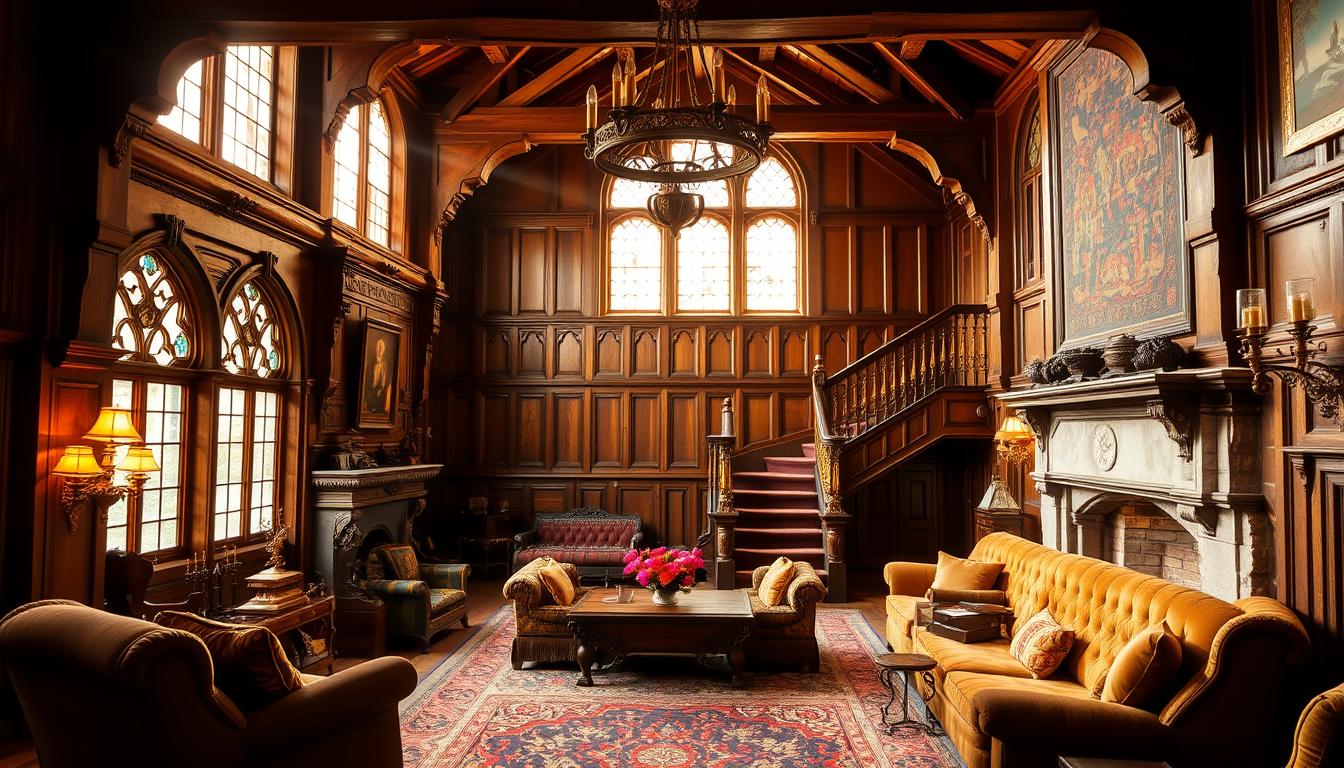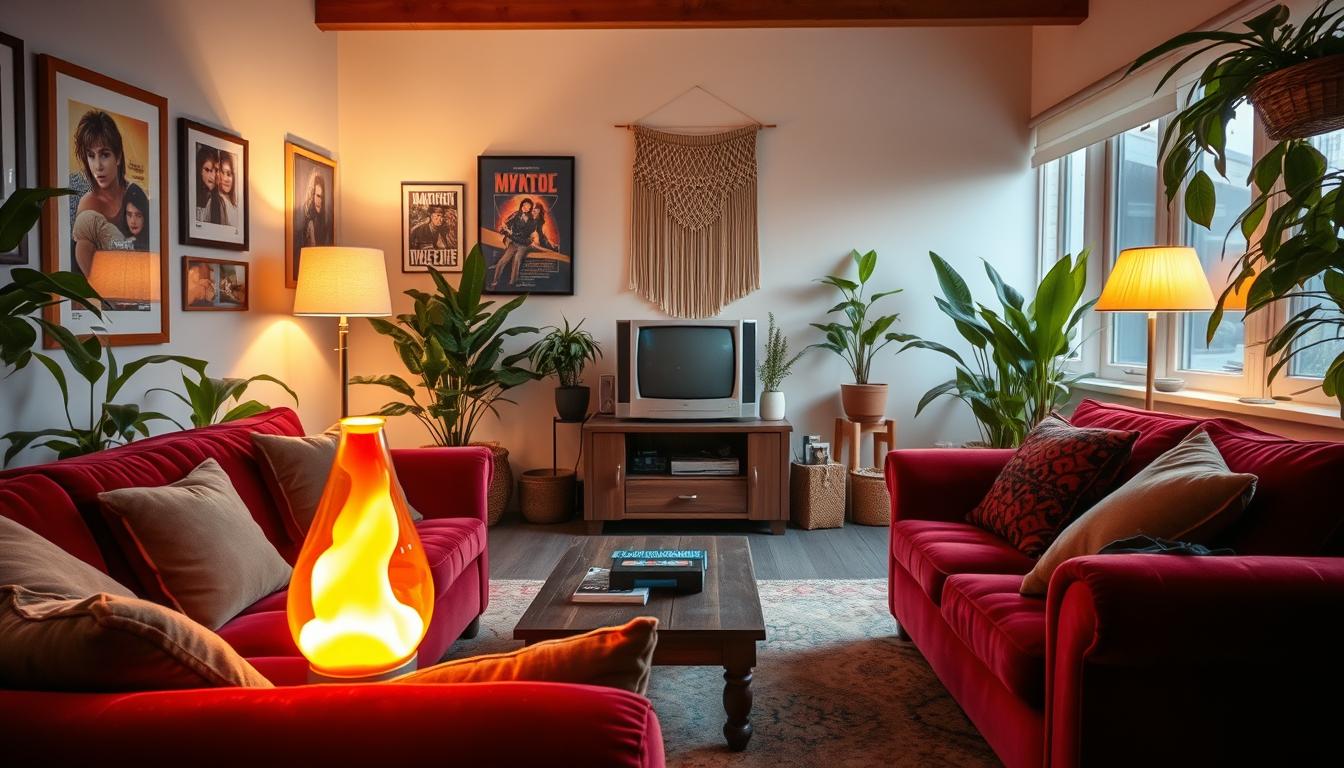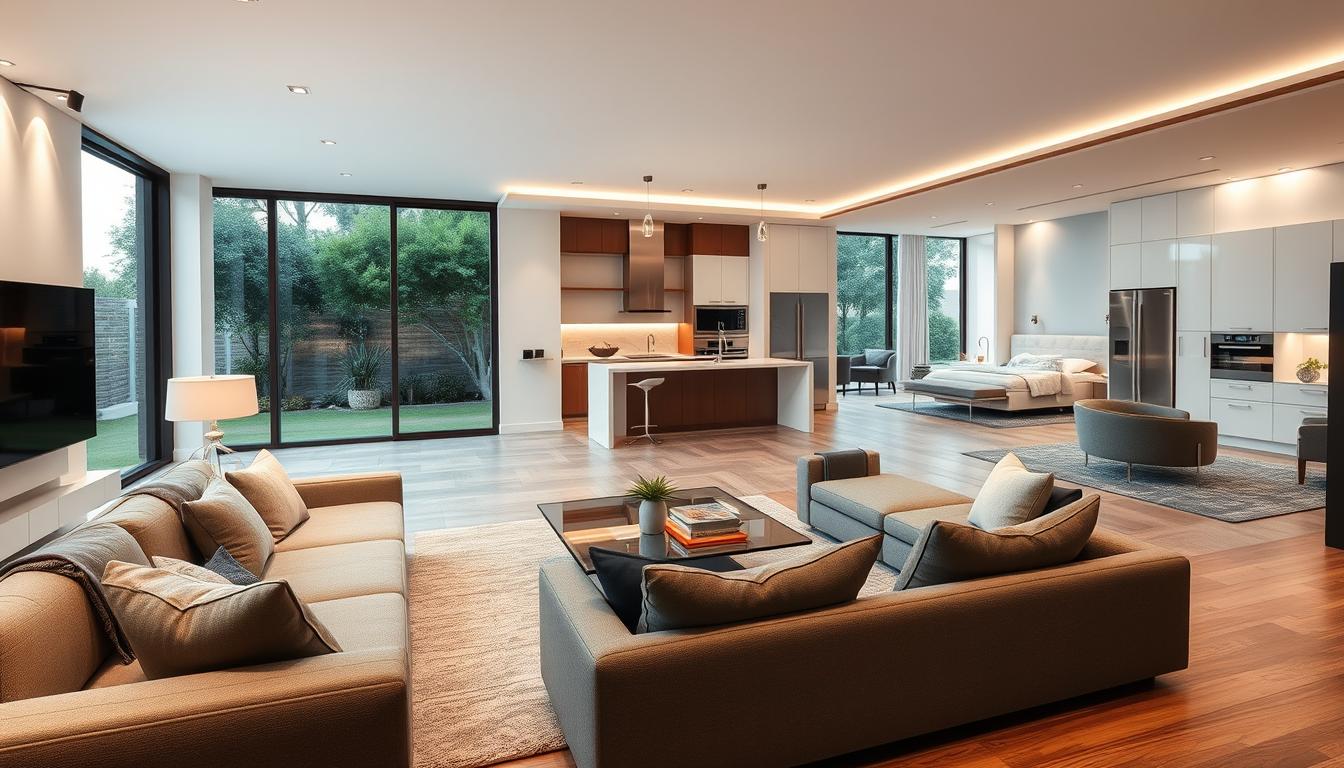The charm of a Tudor-style home is clear. It has a rich history and unique architectural features. Did you know Tudor design started in 16th-century England? It has become a favorite design element around the world.
In this guide, we’ll show you how to create a beautiful Tudor-style interior. We’ll cover key features, color palettes, and furniture choices. These tips will help you get an authentic look.
Key Takeaways
- Understand the historical context and key features of Tudor design
- Learn how to choose a color palette that complements your Tudor-style residence
- Discover the best furniture pieces to enhance your home’s interior
- Explore expert tips for incorporating Tudor design elements into your decor
- Create a beautiful and authentic Tudor-style interior that reflects your personal taste
Understanding Tudor-Style Architecture
To design a Tudor-style home interior, knowing the architectural details is key. Tudor architecture is a mix of elements that bring history and tradition to life.
Key Features of Tudor Homes
Tudor homes stand out with several architectural features. These include:
- Half-timbering: Exposed wooden beams filled with brick, stone, or plaster.
- Steeply pitched roofs: Often with multiple gables and complex rooflines.
- Ornate detailing: Intricate carvings and decorative elements around doors, windows, and chimneys.
These features create a unique and charming look that is truly Tudor.
Historical Context and Origins
The Tudor style began in England in the 16th century, during the Tudor monarchs’ rule. It was influenced by medieval and Renaissance styles. The style used local materials and showed the homeowner’s status.
Tudor homes were built for the wealthy. They showed off wealth with their detailed designs and fine craftsmanship.
Common Materials Used
Tudor homes were made with traditional materials like:
| Material | Primary Use | Notable Characteristics |
|---|---|---|
| Oak Timber | Framing, flooring, paneling | Durable, attractive grain |
| Brick and Stone | Walls, chimneys, decorative elements | Robust, fire-resistant, visually appealing |
| Plaster | Filling timber frames, decorative surfaces | Versatile, can be finished to a high standard |
Understanding these elements helps us see the beauty and complexity of Tudor architecture. This knowledge guides us in designing Tudor-style home interiors.
Embracing Tudor-Style Colors and Textures
Creating a Tudor-style interior means using deep, rich colors and textures. These add warmth and depth. The warmth of Tudor homes comes from their color and material choices.
Recommended Color Palettes
Tudor interiors are known for their rich, earthy tones. Here are some recommended color palettes:
- Deep reds and burgundies, reminiscent of traditional Tudor architecture.
- Earthy browns and taupes, which add warmth and coziness.
- Soft golds and brass tones, often used in decorative accents.
- Muted greens, which can bring a sense of the outdoors inside.
Interior design experts say, “A Tudor-style home’s color palette is not just about looks. It’s about creating a luxurious yet welcoming atmosphere.”
“The right colors can transform a house into a home, making it feel cozy and inviting.”
| Color | Description | Usage |
|---|---|---|
| Deep Red | Rich, bold color | Walls, accent pieces |
| Earthy Brown | Warm, natural tone | Furniture, woodwork |
| Soft Gold | Luxurious, metallic finish | Decorative accents, lighting |
Incorporating Natural Materials
Natural materials are key in Tudor-style interiors. Wood, stone, and brick add texture and warmth.
Wood: Oak, walnut, and other hardwoods are used for flooring, paneling, and furniture.
Stone: Fireplaces and walls often feature stone, adding a rugged, natural element.
Designing for Warmth and Comfort
To achieve Tudor warmth, balance color and texture. Heavy drapery, plush furnishings, and rich textiles create a cozy atmosphere.
When designing our Tudor-style home, we should think about how elements work together. Rich colors, natural materials, and comfortable textiles make a true Tudor-style interior.
Furniture Selection for Tudor Interiors
To create a true Tudor interior, picking the right furniture is key. It should reflect the style’s historical charm and modern comfort. The goal is to honor Tudor craftsmanship while adding today’s needs.
Traditional vs. Modern Furniture
Choosing between traditional and modern furniture is a big decision for Tudor homes. Traditional furniture like ornate wooden chairs and carved cabinets is essential. It adds history and authenticity to your space.
Modern furniture can add a fresh twist, blending old and new. But, it’s important to make sure it fits with the Tudor style, not against it.
Iconic Pieces to Consider
Some furniture is truly iconic for Tudor interiors. These include:
- Ornate wooden chairs with carved details
- Intricately carved wooden cabinets and chests
- Heavy, richly upholstered sofas and armchairs
- Large, wooden dining tables with ornate legs
These pieces showcase Tudor craftsmanship and create a cozy, inviting atmosphere.
Arranging Furniture for Flow
It’s important to arrange furniture for flow and harmony in Tudor interiors. You need to balance the grandeur of the furniture with the need for easy movement.
As
“The way we furnish our homes speaks volumes about our personal style and our connection to history.”
, thoughtful furniture arrangement can enhance the Tudor style while making the space functional.
To achieve this, match your furniture’s size to the room, leave enough space to move, and create areas for conversation.
Crafting Elegant Tudor-Style Living Rooms
A well-designed Tudor living room combines warmth, elegance, and history. To get this look, focus on key elements that define Tudor style.
Focal Points and Fireplace Design
In Tudor homes, the fireplace is a key focal point. A grand, ornate fireplace can be stunning, drawing the eye and creating warmth. Use traditional materials like stone or brick for authenticity.
Arrange furniture around the fireplace for a cozy seating area. This highlights the fireplace and encourages socializing and relaxation.
Choosing the Right Lighting Fixtures
Lighting is crucial in a Tudor-style living room. Choose fixtures that reflect the period, like candelabras, lantern-style lamps, or chandeliers with a medieval flair. These add to the room’s charm and provide necessary light.
Use a mix of lighting types for a layered effect. This allows you to adjust the lighting for different activities and moods.
Textiles and Fabrics That Work
Textiles and fabrics add warmth and texture to a Tudor-style living room. Rich fabrics like velvet, wool, and linen are great for upholstery, drapes, and throw blankets. They offer comfort and luxury.
Choose textiles with Tudor-style colors and patterns. Earthy tones, deep reds, and rich greens are common. Incorporate these to create a welcoming atmosphere.
Designing Functional and Stylish Kitchens
Kitchens in Tudor homes are where function meets style. A well-designed Tudor kitchen combines old charm with new convenience. It makes the space warm and welcoming.
Efficient Layout and Workflow are key in a Tudor kitchen. The layout should make moving around easy, often called the “kitchen triangle.” This ensures the kitchen looks good and works well.
Layout and Workflow Considerations
To get a good layout, think about the “work zones” in your kitchen. These include areas for food prep, cooking, and cleaning. Having these zones clear and arranged well makes your Tudor kitchen better.
As Julia Child said, “The only time to eat diet food is while you’re waiting for the steak to cook.” This shows how important a kitchen that’s both useful and fun is.
Cabinetry in Tudor Homes
Cabinetry is key in Tudor kitchen design. Traditional woods like oak and walnut are often used, with detailed craftsmanship. Raised-panel doors and fancy hardware add to the Tudor look.
When picking cabinetry, think about what fits your Tudor home’s style. Custom or semi-custom cabinets can give you the look you want and lots of storage.
Accessories and Decorative Touches
Accessories and decor can make your Tudor kitchen stand out. Think about adding copper pots, vintage utensils, and classic ceramics. These add character and warmth to your kitchen.
“The kitchen is the heart of the home, and in a Tudor home, it’s a space that beautifully blends tradition with modern comforts.”
By carefully designing your Tudor kitchen, you can make a space that’s both useful and stylish. It captures the true spirit of Tudor style.
Bedrooms with a Tudor Flair
Creating a Tudor-style bedroom is all about design and decor. It’s about making a cozy space that feels like a retreat. Warmth and coziness are key to a Tudor bedroom.
Creating a Cozy Atmosphere
To make your bedroom cozy, use warm colors and textures. Think about oak, walnut, and moss green. These colors bring a traditional Tudor feel and a soothing vibe.
Soft lighting is also important. Table lamps or floor lamps with ornate metalwork add elegance. They also provide warm, gentle light.
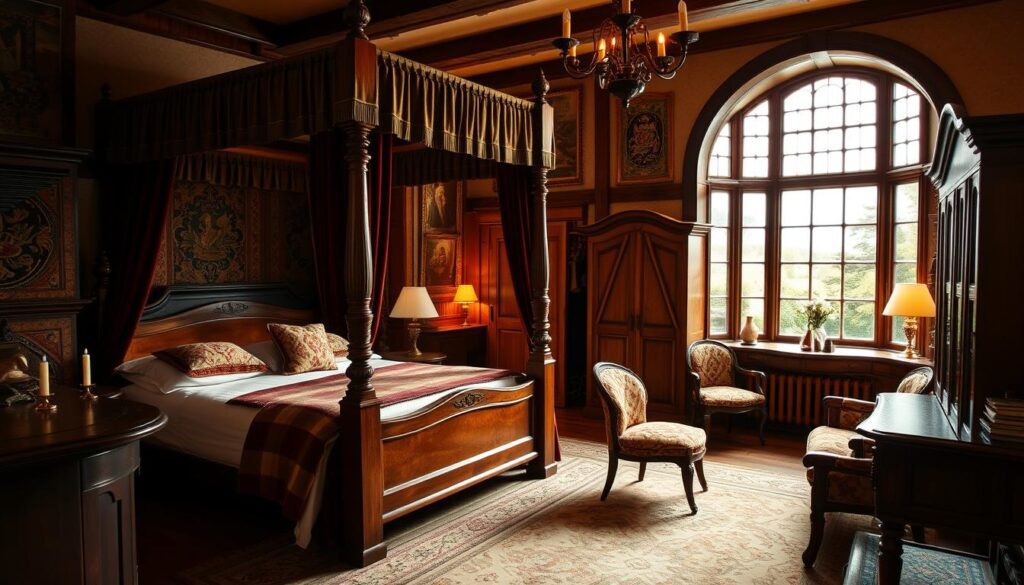
Bed Linens and Textiles
Choosing the right bed linens and textiles is crucial. Go for high-quality fabrics like cotton, linen, or velvet. They’re comfortable and add depth to the room.
Adding traditional patterns like stripes or florals enhances Tudor charm. Mix different textures and patterns for a rich, inviting feel.
Window Treatments for Character
Window treatments are key to a Tudor bedroom’s character. Use heavy, luxurious drapes or curtains. They control light and add drama.
For a true Tudor look, pick window treatments with details like embroidery or ornate tiebacks. These add sophistication and elegance, completing the Tudor style.
Bathrooms Inspired by Tudor Design
Bathrooms in Tudor-style homes mix old charm with modern luxury. When designing a Tudor-inspired bathroom, it’s key to include elements that show the style’s heritage. At the same time, make sure it’s functional.
Luxurious Features to Include
To capture Tudor design’s essence, think about adding freestanding tubs and fancy fixtures. These features not only look great but also make bathing better.
A claw-foot tub can be a beautiful centerpiece, showing Tudor-era opulence. Also, a walk-in shower with detailed tile work can make the space even richer.
Tile and Flooring Options
Choosing the right tile and flooring is key for a true Tudor bathroom. Traditional materials like marble and stone are great. They’re durable and look good.
- Marble tiles can bring sophistication, perfect for flooring or around the bathtub.
- Stone flooring, like limestone or slate, adds a rustic, earthy feel that fits Tudor style.
Fixtures That Enhance Elegance
Fixtures are crucial for a Tudor-inspired bathroom’s elegance. Choose faucets and shower heads with a vintage or ornate look to add charm.
Go for brass or bronze finishes for a real look, as these metals were used in old Tudor homes. Also, fancy lighting can make the space warm and welcoming.
Outdoor Spaces That Complement Tudor Homes
Creating an outdoor space for a Tudor home needs careful thought. The home’s traditional charm should shine in the outdoor areas. We’ll look at how to match the home’s look with good design, furniture, and inviting spaces.
Landscape Design Principles
Designing the landscape for a Tudor home means using elements that match its style. Boxwood hedges, stone pathways, and traditional flowers are great choices. They bring an authentic feel.
Using natural materials like wood, stone, and brick is also key. These materials warm up the outdoor space and match the home’s look.
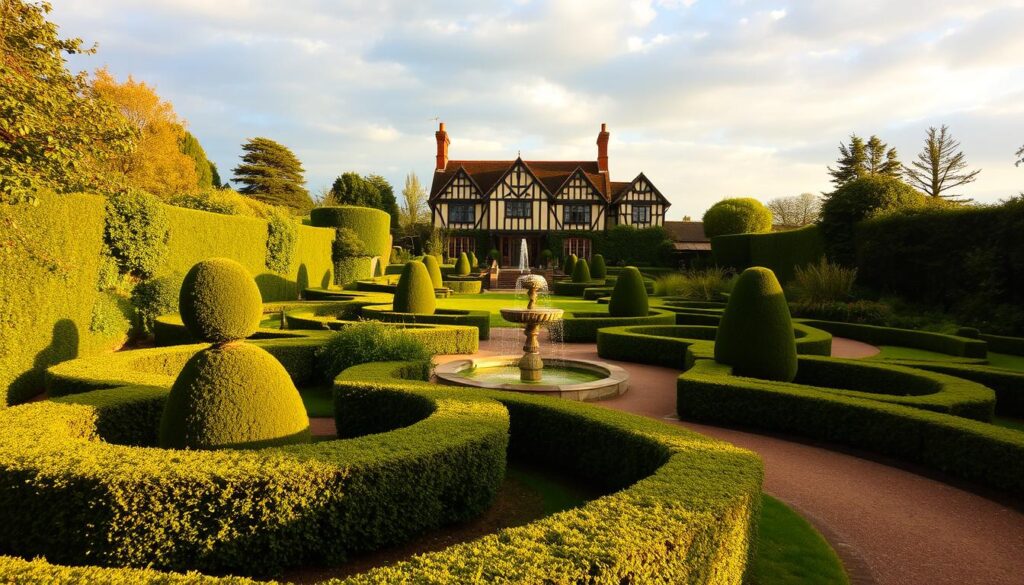
Selecting Outdoor Furniture
Choosing the right outdoor furniture is crucial. Go for oak or wrought iron pieces with classic designs. They fit perfectly with Tudor architecture.
| Furniture Material | Style | Compatibility with Tudor Homes |
|---|---|---|
| Oak Wood | Traditional | High |
| Wrought Iron | Classic | High |
| Modern Plastic | Contemporary | Low |
Creating Inviting Patios and Gardens
Patios and gardens make outdoor spaces welcoming. For Tudor homes, aim for cozy, intimate designs. Use stone or brick pavers for patios and add greenery and flowers for a calm vibe.
Outdoor lighting, like lanterns or traditional sconces, can enhance the look. It adds beauty and function to your outdoor areas.
Personalizing Your Tudor-Style Home
Exploring Tudor-style home decor shows us the importance of personal touches. While sticking to traditional Tudor style is key, adding personal elements makes a house truly feel like home.
There are many ways to personalize a Tudor home. You can use family heirlooms, choose artwork and decorative items, and add customized touches.
Integrating Family Heirlooms
Family heirlooms bring history and personal meaning to your Tudor home. Think about adding antique furniture, vintage textiles, or other items passed down through your family.
For example, an old armchair can get a new look with modern fabric that fits the Tudor style. This way, you mix tradition with your own taste.
Artwork and Decorative Accessories
Art and decorative items are great for adding your personal touch. Pick pieces that show your style but also fit the Tudor look.
Look for art inspired by medieval or Renaissance times. Or, choose decorative items that remind you of Tudor architecture’s detailed designs.
The Role of Customization
Customization is key to making your Tudor home unique. You can add custom cabinetry, bespoke furniture, and more to give your home a personal touch.
Collaborate with craftsmen or designers who know Tudor style. They can help you create special pieces that honor tradition and show your individuality.
| Customization Idea | Tudor Style Element | Personal Touch |
|---|---|---|
| Custom Cabinetry | Ornate carvings | Personalized monogram or family crest |
| Bespoke Furniture | Heavy oak construction | Upholstered with family heirloom fabric |
| Decorative Accessories | Intricate metalwork | Custom-designed pieces reflecting personal interests |
By carefully choosing these elements, you can make a Tudor-style home that’s both authentic and uniquely yours.
Tips for Maintenance and Updates
Maintaining and updating a Tudor-style home needs careful thought. It’s important to keep its unique character. When doing renovations, mix old charm with new touches.
To keep your Tudor home’s special features, like wooden beams and stained glass, intact. Update wisely, choosing materials and designs that match the home’s interior.
Preserving Original Features
Keep details like wooden beams and stained glass windows to keep the home authentic.
Renovation Considerations
Choose materials and designs that fit with the home’s interior. This ensures a smooth mix of old and new.
Avoiding Common Pitfalls
Watch out for modernizing too much or using the wrong materials. Avoid sleek fixtures and bright colors. They can lose the home’s historic charm.
By keeping these tips in mind, you can update your Tudor home well. This way, it stays beautiful and true to its style, showing off great renovation and design for years.

